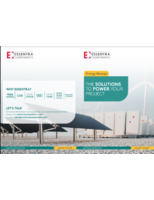Software simulates liquid composite molding.
Share:
Press Release Summary:
PAM-RTM 2004 provides solution for preliminary design, as well as refined calculations for process mold optimization and final design verification. It simulates resin transfer molding, vacuum assisted RTM, and vacuum assisted resin infusion for manufacture of very large composite parts. Software offers contact resistance for thermal modeling, air bubble entrapment detection, user-defined viscosity and curing, and mesh modification for runners and injection points.
Original Press Release:
Latest Version of ESI Group Liquid Composite Molding Simulation Software Targets New Manufacturing Process
PAM-RTM 2004 enables simulation of very large composite structures using the Vacuum Assisted Resin Infusion (VARI) process
NUMIFORM, Columbus, Ohio, June 13, 2004: ESI Group today launched PAM-RTM 2004, a Liquid Composite Molding (LCM) simulation software package. PAM-RTM 2004 provides rapid solutions for preliminary design, as well as refined calculations for process and mold optimization, and final design verification. The product is uniquely suited to simulate a wide range of manufacturing processes, including Resin Transfer Molding (RTM), Vacuum Assisted RTM (VARTM), and now with the 2004 release, Vacuum Assisted Resin Infusion (VARI). VARI is one of the few processes that can be used to efficiently manufacture very large composite parts such as windmill blades, ship decks and hulls, and large aircraft parts. Due to their size, such large structures cannot be manufactured with traditional closed molds. VARI simulation is now possible because the permeability variations caused by the deformation of fibrous reinforcement during resin injection are taken into account.
"With PAM-RTM 2004 engineers are now able to anticipate future manufacturing issues or problems that could not be simulated before when designing large components. It helps them drastically reduce manufacturing costs, as any failure would generate tremendous waste due to the large amounts of resin and fiber involved in these projects, not to mention the cost of the mold," said Patrick de Luca, Product Manager, ESI Group.
The optimization of PAM-RTM 2004 CPU management offers a version that is twice as fast as the previous release. Among the many new capabilities found in PAM-RTM 2004 are a new contact resistance for thermal modeling and improved functionality for air bubbles entrapment detection. In addition, users can now define their own viscosity and curing functions, which enables them to simulate new resins as they come to market.
The user-friendly interface, based on Microsoft Windows architecture, offers improved visualization: a model explorer helps, for instance, locate materials or boundary conditions directly on the model. Data output analysis is also further simplified with the possibility of generating animations.
PAM-RTM 2004 offers a seamless integration of the solver, pre and post-processing. Automatic mesh modification is available for runners and injection points. This new functionality offers significant time-saving in the process-tuning and optimization of runners and positioning of injection gates, since the mesh modifications are done directly in PAM-RTM 2004 rather than going back to the CAD model.
PAM-RTM 2004 is available on PCs (Windows NT, 2000, XP), on Unix workstations from IBM, and hardware vendors' supported Linux platforms.
ESI Group's composite solutions will be showcased at NUMIFORM 2004 conference, Columbus, Ohio, June 13, 2004.
About ESI Group
ESI Group is a pioneer and world leading provider of digital simulation software for prototyping and manufacturing processes that take into account the physics of materials. ESI Group has developed an entire suite of coherent industry-oriented applications to realistically simulate a product's behavior during testing, to fine tune the manufacturing processes in synergy with the desired product performance, and to evaluate the environment's impact on product usage. ESI Group's product portfolio, which has been industrially validated and combined in multi-trade value chains, represents a unique collaborative, virtual engineering solution, known as the Virtual Try-Out Space (VTOS), enabling a continuous improvement on the virtual prototype. By drastically reducing costs and development lead times, VTOS solutions offer major competitive advantages by progressively eliminating the need for physical prototypes. With revenues close to 49 million euros in fiscal year 2003, ESI Group (Nouveau Marchi: Euronext Paris - Software - Euroclear 6584 - Bloomberg ESI FP - Reuters ESIG.LN) employs almost 500 high-level specialists worldwide. The company and its global network of agents provide sales and technical support to customers in more than 30 countries.
On the Net: ESI Group site: www.esi-group.com




